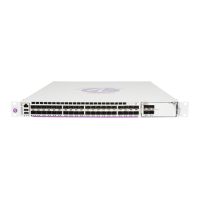Pseudowire Switching
Page 178 7705 SAR OS Services Guide
• When the local operational status for any of the spokes is down, the S-PE always
sends SDP-binding down status bits regardless if the received status bits from the
remote node indicated SAP up or down or SDP-binding up or down.
When one segment of the pseudowire cross-connect at the S-PE is static while the other is
signaled using TLDP, the S-PE operates much like a T-PE from a signaling perspective and
as an S-PE from a data plane perspective. The S-PE signals a label mapping message as soon
as the local configuration is complete. The control word C-bit field in the pseudowire FEC is
set to the value configured on the static spoke SDP.
When the label mapping for the egress direction is also received from the TLDP peer, and
the information in the FEC matches that of the local configuration, the static-to-dynamic
cross-connect is established.
In a static-to-dynamic pseudowire switching service, it is possible for the end nodes of the
static pseudowire segment to be misconfigured. In this case, an S-PE or T-PE node may
receive packets with the wrong encapsulation. If this happens, an invalid payload might be
forwarded over the pseudowire or the SAP respectively.
Furthermore, if the S-PE or T-PE node is expecting the control word in the packet
encapsulation, and the received packet arrives with no control word but the first nibble
below the label stack is 0x0001, the packet may be mistaken for a VCCV OAM packet and
may be forwarded to the CSM. In that case, the CSM will perform a check of the IP header
fields. If any of the fields fail the check, the VCCV packet will be discarded.
Pseudowire Switching With IP Tunnels
You cannot enable TLDP dynamic pseudowire establishment on pseudowire switching
segments using IP tunnels if the second pseudowire segment is configured for pseudowire
redundancy. The pseudowire label, control word, VCCV type, and so on, must be configured
manually.
On the first pseudowire segment, ATM pseudowires are natively transported over IP using
GRE encapsulation with the IP type set to 0x8847, or IP encapsulation. The destination IP
address of pseudowire packets received from the Node B must be set to the system IP or
interface IP address of the 7705 SAR. Similarly, the destination IP address of pseudowire
packets received from the 7750 SR must be set to the system IP or interface IP address of the
Node B. Node B management traffic is transported over the same Ethernet link between the
7705 SAR and the Node B. The 7705 SAR forwards the management IP traffic to its
destination based on longest prefix match.
On the second pseudowire segment, ATM pseudowires are transported over MPLS tunnels.
The MPLS tunnels can also be used to transport additional cell site traffic, such as BTS
traffic using TDM pseudowires, or LTE base station traffic using IP or Ethernet
pseudowires.

